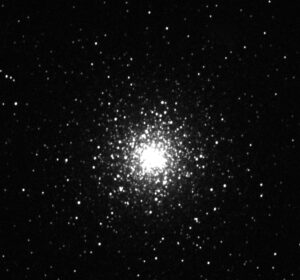By Ghanim Jamil
ghj729
Globular clusters are studied by astronomers to gain a better understanding of the galaxy they reside in, and in general estimate the age of the universe. This blog is about the globular cluster NGC 5024, also known as Messier 53. This cluster was discovered in 1775, February 3rd by a German-born British astronomer Johann Elert Bode. Later, Charles Messier rediscovered this cluster on February 26th, 1777 (Tammy Plotner, 2017), and included it in his famous Messier Catalogue, hence being called Messier 53. Located in the Coma Berenices constellation, it is an old cluster, being about 12.6 billion years old, and about 18 kpcs away from us (58×10^3 ly). It is a metal-poor cluster, which means that its group of stars has a low abundance of elements heavier than hydrogen and helium.
Studying this cluster was a part of my FYRE (first-year research experience) assignments, I was instructed to observe this cluster with blue, green, and red filters using the Skynet Robotic Telescopes with a 1-3 second image an hour interval. In total, I collected 15 images to be analyzed by Skynet’s image processing website, Afterglow.



These images were analyzed in Afterglow to create a true (reddened) image of the cluster.

A reddened image is what an interstellar object would seem from Earth, as the image is clouded by the interstellar medium; matter, and radiation that exists in space between stars and galaxies. A non-reddened image would be what an object would look like if we were to be observing it from space. To create a reddened image, I used Cluster Pro Plus software, which allowed me to import my Afterglow modeling data into an Isochrone model.

The isochrone model also let me determine other useful data about the cluster. Here is a table showing the values that I arrived at using this isochrone model.
| Log(age) | Metalicity (solar mass unit) | B-V (mag) | Distance (kpc) |
| 9.52 | -1.54 | 0.02 | 24.27 |
Its corresponding Isochrone model:

What I was able to deduce from this data was that my cluster had an overall poor metalicity value, which was correct with data found from Wikipedia and other blog articles about this globular cluster.
Overall, this was a fun FYRE assignment to do, I was joyed to do my own calculations for a globular cluster, and I felt a little closer to how professional astronomers observe interstellar objects and how they analyze them. What I learned from this assignment was that a general rule of thumb to determine the age of a globular cluster is to look at its dominant color, if its mostly blue, its relatively new, or if its orange, its relatively old. Obviously more accurate methods exist to determine a cluster’s age (using an isochrone model as shown above), and just because its dominated by blue stars doesn’t mean its new, but this rule of thumb is more susceptible to a general audience.
References: